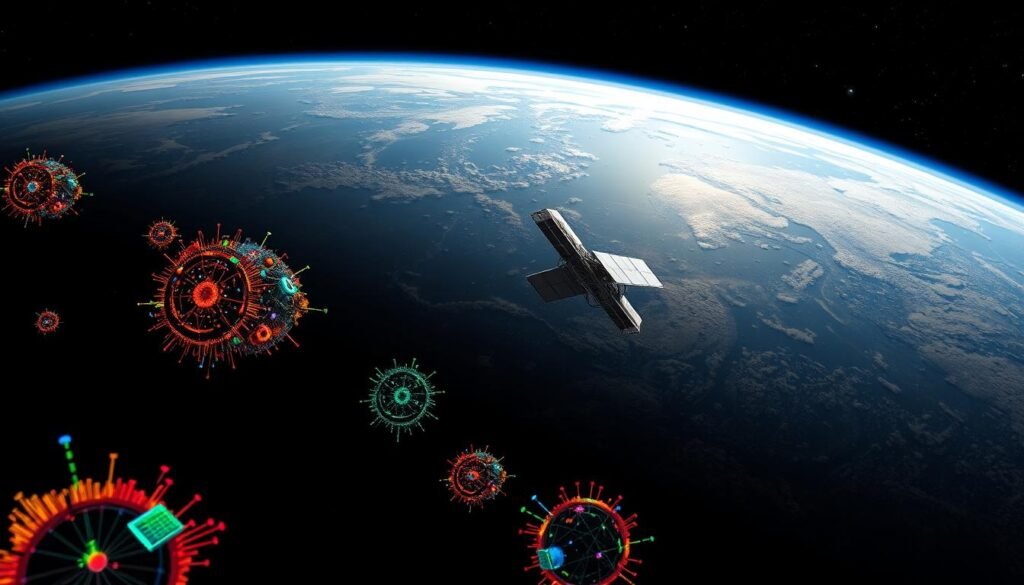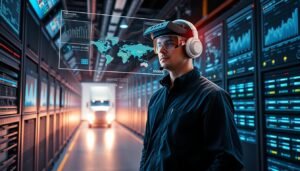Data science in space exploration is transforming the way we understand and execute missions beyond our planet. By processing and analyzing vast volumes of data, scientists are uncovering patterns and insights that were once beyond our reach. This powerful technology now lies at the core of modern advancements, fueling innovation in satellite operations, spacecraft systems, and mission planning.
From tracking orbital trajectories to predicting asteroid paths, data science plays a pivotal role in ensuring the success and safety of space missions. It also enables real-time communication between Earth and astronauts, enhancing mission efficiency and reducing risks.
In this article, we’ll explore the evolution of data science in space — from its early applications to the latest cutting-edge technologies. Join us on this journey through the cosmos as we examine how data-driven research and innovation are redefining the future of space travel and unlocking new frontiers for humanity.
Key Takeaways
- Data science is essential for analyzing complex datasets from missions.
- It enables real-time monitoring of orbits and spacecraft systems.
- Advanced technologies are improving communication and safety for astronauts.
- Historical achievements and modern advancements are both covered in this guide.
- Data-driven insights are shaping the future of space travel.
Introduction and Overview
The fusion of data science and space missions has revolutionized how we plan and execute journeys beyond Earth. By analyzing vast datasets, scientists can make informed decisions that ensure the success of both crewed and uncrewed missions. This synergy is driving innovation in satellite technology, planetary studies, and beyond.
Defining Data Science in the Space Context
In the realm of space, data science involves collecting, processing, and interpreting information from various sources. This includes satellite imagery, telemetry data, and even historical mission records. Statistical models and machine learning play a crucial role in uncovering patterns that were once hidden.
For example, data science helps predict asteroid paths, monitor orbits, and optimize spacecraft systems. These insights are vital for ensuring mission safety and efficiency. By leveraging advanced algorithms, researchers can make real-time decisions that enhance communication between Earth and astronauts.
The Intersection of Data and Space Missions
Data science is not just about numbers; it’s about transforming raw information into actionable insights. Take satellite launches, for instance. Analyzing historical data allows engineers to identify potential risks and improve launch strategies. This approach has been instrumental in successful missions to Mars and other planets.
Collaboration is another key aspect. Data from international space stations, research institutions, and commercial ventures are integrated to create a comprehensive picture. This collective effort ensures that every mission benefits from the latest advancements in technology and research.
If you’re interested in learning more about data science, check out these free resources to get started. The future of space exploration is data-driven, and the possibilities are endless.
Historical Milestones in Space Exploration
The journey of human achievement beyond Earth began with groundbreaking milestones that reshaped our understanding of the universe. From the first satellite launch to the continuous operation of the International Space Station, these achievements have inspired generations and laid the foundation for modern advancements.

Key Mission Achievements from Sputnik to the ISS
In 1957, the launch of Sputnik 1 marked the dawn of the space age. This first artificial satellite opened the door for further exploration and technological innovation. Just four years later, Yuri Gagarin became the first human to orbit Earth, a feat that demonstrated the potential of crewed missions.
The 1960s saw the U.S. achieve a monumental milestone with the Apollo 11 mission. In 1969, Neil Armstrong and Buzz Aldrin became the first humans to walk on the moon, a moment that united the world in awe. This era also witnessed significant advancements in rocket technology, with the Saturn V rocket playing a pivotal role in these missions.
By the late 20th century, the focus shifted to long-term habitation in orbit. The International Space Station (ISS), launched in 1998, became a symbol of global collaboration. It has hosted astronauts from various countries, fostering research that benefits life on Earth and beyond.
These milestones were not just about reaching new heights; they also involved collecting valuable data. Early missions provided insights into Earth’s atmosphere, the moon’s surface, and the challenges of living in space. This information paved the way for future missions to Mars and other planets.
Today, the legacy of these achievements continues to inspire. From satellite technology to advanced spacecraft systems, the groundwork laid by these pioneers ensures that the future of space exploration remains bright and full of possibilities.
How Data Science is Shaping Modern Space Missions
Modern space missions are increasingly relying on advanced data science to achieve unprecedented levels of precision and efficiency. From monitoring satellite orbits to ensuring the safety of astronauts, data-driven insights are transforming how we approach these complex endeavors.
Enhanced Data Analytics in Orbit
Cutting-edge data analytics are now a cornerstone of mission success. For example, machine learning algorithms process vast amounts of satellite data to refine orbital paths and predict potential collisions. This ensures that satellites remain operational and avoid hazards.
NASA’s use of predictive maintenance is a prime example. By analyzing telemetry data, they can identify system anomalies before they escalate. This proactive approach minimizes downtime and extends the lifespan of critical equipment.
Real-Time Decision Support in Spacecraft Operations
Real-time data processing is revolutionizing spacecraft operations. During missions, telemetry data is continuously analyzed to provide actionable insights. This allows ground control to make informed decisions quickly, enhancing both safety and efficiency.
For instance, during the Mars rover missions, real-time feedback enabled engineers to adjust navigation paths and avoid obstacles. This level of precision would be impossible without advanced data science tools.
| Technology | Application | Impact |
|---|---|---|
| Machine Learning | Orbital Path Optimization | Reduces collision risks |
| Predictive Maintenance | System Anomaly Detection | Extends equipment lifespan |
| Real-Time Analytics | Spacecraft Navigation | Enhances mission safety |
As the demand for skilled data scientists grows, professionals are encouraged to master programming languages, statistical analysis, and machine learning fundamentals. Continuous learning is key to excelling in this dynamic field. For those interested, check out these resources to get started.
The future of space missions is undeniably data-driven. With every technological advancement, we move closer to unlocking new possibilities for humanity.
Innovations in Space Exploration: The Data Science Advantage
The integration of data science into satellite systems is redefining how we observe and analyze our planet and beyond. By leveraging advanced technologies, researchers can now collect and process information with unparalleled precision. This synergy is transforming the way we approach missions and uncover new insights.

Advancements in Satellite Technology and Remote Sensing
Satellite technology has seen remarkable progress in recent years. Modern satellites are equipped with high-resolution sensors that capture detailed images of Earth and other planets. These instruments provide valuable data for climate monitoring, disaster management, and resource detection.
For example, the Landsat program has been instrumental in mapping changes in land use and vegetation. Similarly, the Sentinel satellites under the Copernicus program offer real-time environmental data. These advancements are crucial for understanding our planet and addressing global challenges.
Emerging Data-Driven Analytics Tools for Space Research
Data-driven analytics tools are revolutionizing space research. Machine learning algorithms analyze vast datasets to identify patterns and predict outcomes. This approach enhances the accuracy of planetary mapping and resource detection.
One notable innovation is the use of hyperspectral imaging. This technology captures detailed spectral information, enabling researchers to identify minerals and water sources on other planets. Additionally, big data integration allows for real-time analysis of remote operations, improving mission efficiency.
| Technology | Application | Impact |
|---|---|---|
| Hyperspectral Imaging | Resource Detection | Identifies minerals and water sources |
| Machine Learning | Planetary Mapping | Enhances accuracy and detail |
| Big Data Integration | Remote Operations | Improves mission efficiency |
These innovations highlight the competitive edge that data science provides in modern space exploration. By combining cutting-edge technology with advanced analytics, researchers are unlocking new possibilities for humanity’s future in the cosmos.
Collaborative Efforts and International Partnerships
Global collaboration has become the backbone of modern space missions, uniting nations in a shared quest for discovery. By pooling resources and expertise, countries are achieving milestones that would be impossible alone. This cooperative spirit is transforming the way we approach complex challenges, from satellite launches to crewed missions.
One of the most iconic examples of international teamwork is the International Space Station (ISS). This orbiting laboratory has hosted astronauts from over 20 countries, fostering groundbreaking research in microgravity, biology, and climate science. The ISS is a testament to what humanity can achieve when we work together.
The Role of Key Astronauts and Specialists
Behind every successful mission are the dedicated astronauts and specialists who bring these projects to life. Individuals like Kayla Barron and Jessica Watkins have played pivotal roles in advancing our understanding of life beyond Earth. Their contributions extend beyond technical expertise; they inspire future generations to pursue careers in science and technology.
Collaborative efforts also improve operational command structures. For instance, real-time data sharing between international teams ensures smoother mission execution. This approach was crucial during the Mars rover missions, where engineers from multiple countries worked together to navigate the planet’s challenging terrain.
- Shared expertise accelerates innovation in data science applications.
- Multinational initiatives like the ISS highlight the benefits of global teamwork.
- Specialized astronauts and experts drive mission success and inspire future explorers.
As we look to the future, international partnerships will remain essential. From lunar bases to missions to distant planets, these cooperative ventures ensure that humanity’s journey into the cosmos is both safe and successful.
Future Trends and Emerging Technologies in Space Science
The future of space science is being shaped by groundbreaking technologies and innovative research initiatives. From private sector investments to ambitious missions, the next decade promises to redefine our understanding of the cosmos. These advancements are not only expanding humanity’s reach but also opening new possibilities for discovery and resource management.
Commercial Space Ventures and Research Initiatives
Private companies are playing a pivotal role in the evolution of space science. Firms like SpaceX and Blue Origin are driving innovation with reusable rockets and cost-effective launch systems. These efforts are making space more accessible, enabling smaller organizations to participate in research and exploration.
Collaborative initiatives between commercial entities and research institutions are also gaining momentum. For example, partnerships are focusing on satellite technology for climate monitoring and disaster response. These projects highlight the potential of combining private sector efficiency with scientific expertise.
Upcoming Missions and Technological Breakthroughs
NASA’s Orion mission and planned crewed flights to Mars in the 2030s are among the most anticipated endeavors. These missions aim to explore new frontiers and gather data that could pave the way for sustainable human presence on other planets.
Technological advancements are also transforming spacecraft design and satellite systems. Innovations like hyperspectral imaging and advanced propulsion systems are enhancing our ability to study distant planets and optimize orbital paths. These breakthroughs are crucial for the success of future missions.
| Innovation | Application | Impact |
|---|---|---|
| Reusable Rockets | Cost-Effective Launches | Makes space more accessible |
| Hyperspectral Imaging | Planetary Resource Detection | Identifies minerals and water sources |
| Advanced Propulsion | Interplanetary Travel | Reduces mission duration |
As we look ahead, these trends and technologies will continue to shape the future of space science. By fostering collaboration and embracing innovation, humanity is poised to achieve remarkable milestones in the years to come.
Conclusion
From early missions to the moon to advanced satellite systems, data science has been a driving force in humanity’s journey beyond Earth. It has transformed how we plan and execute missions, ensuring safety and efficiency in every step. Historical milestones, like the Apollo program, laid the groundwork for today’s innovations, while modern tools like machine learning are shaping the future of exploration.
Global collaboration has also played a key role. Partnerships between nations and private companies have accelerated advancements, making missions to Mars and beyond more achievable. Data analytics continues to enhance mission planning, from optimizing orbit paths to predicting potential risks.
As we look ahead, the possibilities are endless. With cutting-edge technologies and a shared commitment to discovery, humanity is poised to achieve even greater milestones. Thank you for joining us on this journey into how data science is revolutionizing our quest to explore the cosmos.






















15 thoughts on “Data Science in Space Exploration: Unlocking the Universe with Big Data”
I was reading through some of your posts on this internet site and I believe this web site is really instructive! Keep on putting up.
Hello! Do you know if they make any plugins to protect against hackers? I’m kinda paranoid about losing everything I’ve worked hard on. Any suggestions?
Outstanding post, you have pointed out some superb points, I as well conceive this s a very good website.
**mind vault**
mind vault is a premium cognitive support formula created for adults 45+. It’s thoughtfully designed to help maintain clear thinking
I conceive this website has some real great info for everyone : D.
I have learn a few excellent stuff here. Definitely worth bookmarking for revisiting. I wonder how a lot effort you put to create this sort of excellent informative web site.
You have remarked very interesting points! ps decent internet site. “Every man over forty is a scoundrel.” by George Bernard Shaw.
Howdy! I’m at work surfing around your blog from my new iphone! Just wanted to say I love reading your blog and look forward to all your posts! Carry on the fantastic work!
**breathe**
breathe is a plant-powered tincture crafted to promote lung performance and enhance your breathing quality.
What a comprehensive overview.
Hey there, You’ve performed an incredible job. I’ll certainly digg it and in my view recommend to my friends. I am confident they will be benefited from this website.
I really like your writing style, superb information, appreciate it for posting : D.
I don’t unremarkably comment but I gotta admit thanks for the post on this great one : D.
Some truly fantastic blog posts on this web site, appreciate it for contribution.
What i don’t understood is in fact how you are not really much more well-favored than you may be right now. You are very intelligent. You realize therefore considerably in terms of this topic, made me in my opinion believe it from a lot of various angles. Its like men and women are not fascinated unless it’s one thing to accomplish with Girl gaga! Your personal stuffs great. At all times handle it up!